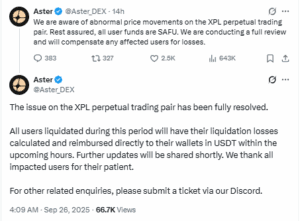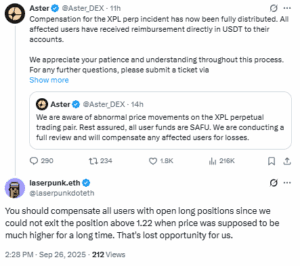Traders are demanding more than refunds after a glitch on Aster DEX blocked them from profiting during XPL’s debut. The exchange reimbursed liquidation losses in USDT, but many users argue that the payouts do not cover the gains they missed when contracts failed to track the market.
Glitch Sends XPL Perps to $4 While Spot Holds $1.30
Plasma’s XPL token surged more than 50% during its launch on Sept.25, but the rally was overshadowed by a glitch on Aster DEX. XPL perpetual contracts briefly spiked to $4, even as spot markets stayed near $1.30.

Aster refunded users in USDT after abnormal liquidations, but many traders say the payouts did not cover the profits they missed when the system failed.

During the opening hours of XPL trading, Aster’s perpetual contracts malfunctioned. The exchange later admitted that the index price had been fixed at $1 and the mark price capped at $1.22. When the cap was removed without correcting the index, the contracts spiked to almost $4 within minutes. The mispricing led to forced liquidations for some accounts and left long traders unable to close positions above $1.22.
Aster Covers Liquidations, But Stops at Direct Losses
Aster said it fully reimbursed liquidation losses and trading fees in USDT. The refunds were distributed directly to affected wallets. The exchange told users that “all funds are SAFE” and claimed the issue was “fully resolved.”
This quick response addressed the most visible damage. But the platform drew criticism for limiting refunds to actual losses, while ignoring the opportunity cost of missed gains from XPL.
Not all users were satisfied with Aster’s solution. On X, traders argued that they should be compensated for the money they would have made if they could have closed their long positions above $1.22.

For these traders, refunds were not enough. They say the glitch robbed them of profits at a time when XPL was surging on other exchanges.
Scale of XPL’s $2.4B Debut Amplifies Fallout
The issue gained attention because of the scale of XPL’s debut. The token launched with a market capitalization above $2.4 billion and reported more than $2 billion in stablecoin deposits on day one. Trading volume exceeded $6 billion within the first 24 hours, placing it among the most active new tokens of the year. As of now, XPL to USD is trading near $1.18, up 29% from a day ago.
By comparison, Ethereum (ETH) launched in July 2015 with a market cap of about $54 million. Solana (SOL) went live in March 2020 with an implied launch valuation around $110–125 million. Avalanche (AVAX) debuted in September 2020 with a market cap near $100 million.
That means XPL’s debut valuation was roughly 44 times larger than Ethereum’s, 20 times larger than Solana’s. No other recent Layer-1 blockchain has entered the market at such scale.
